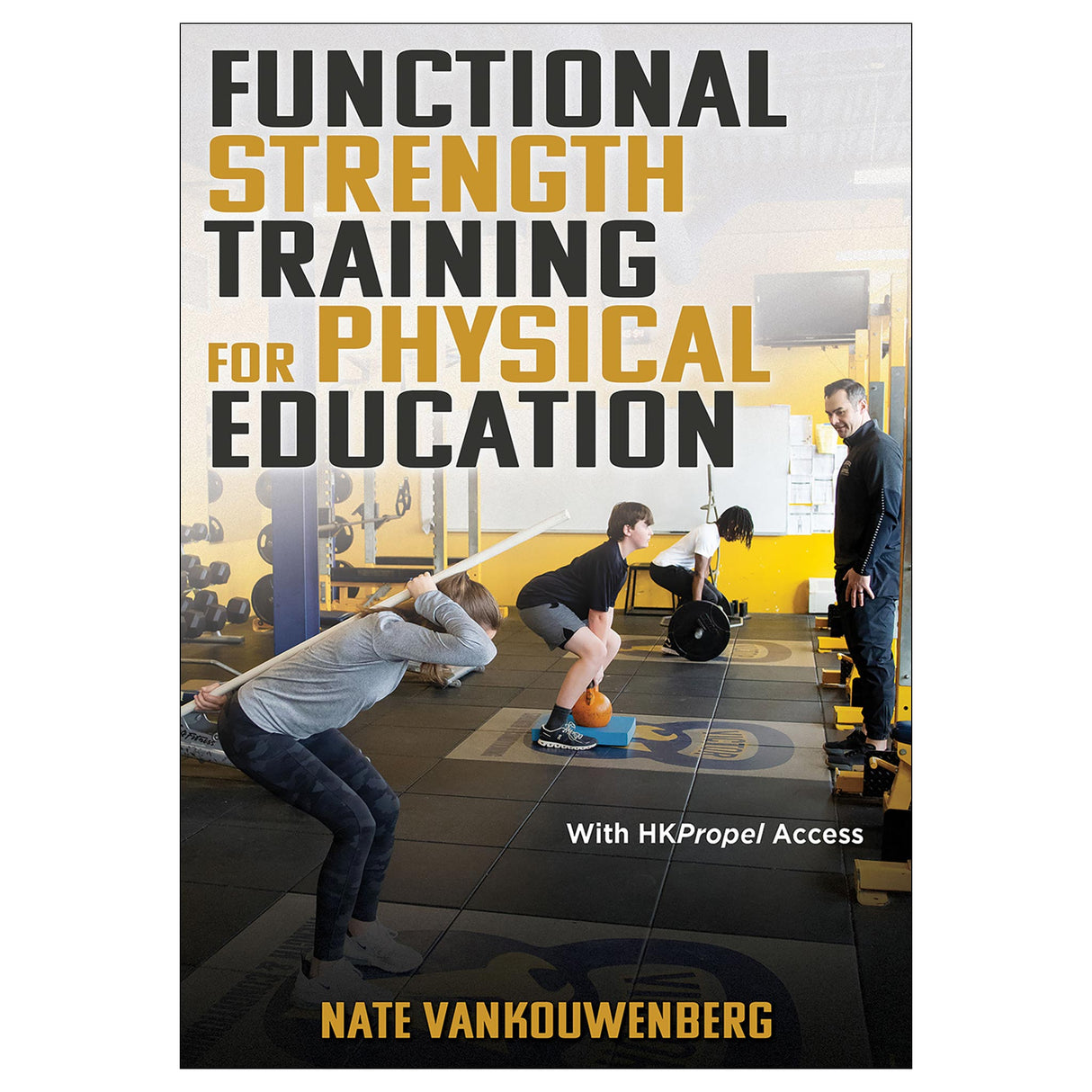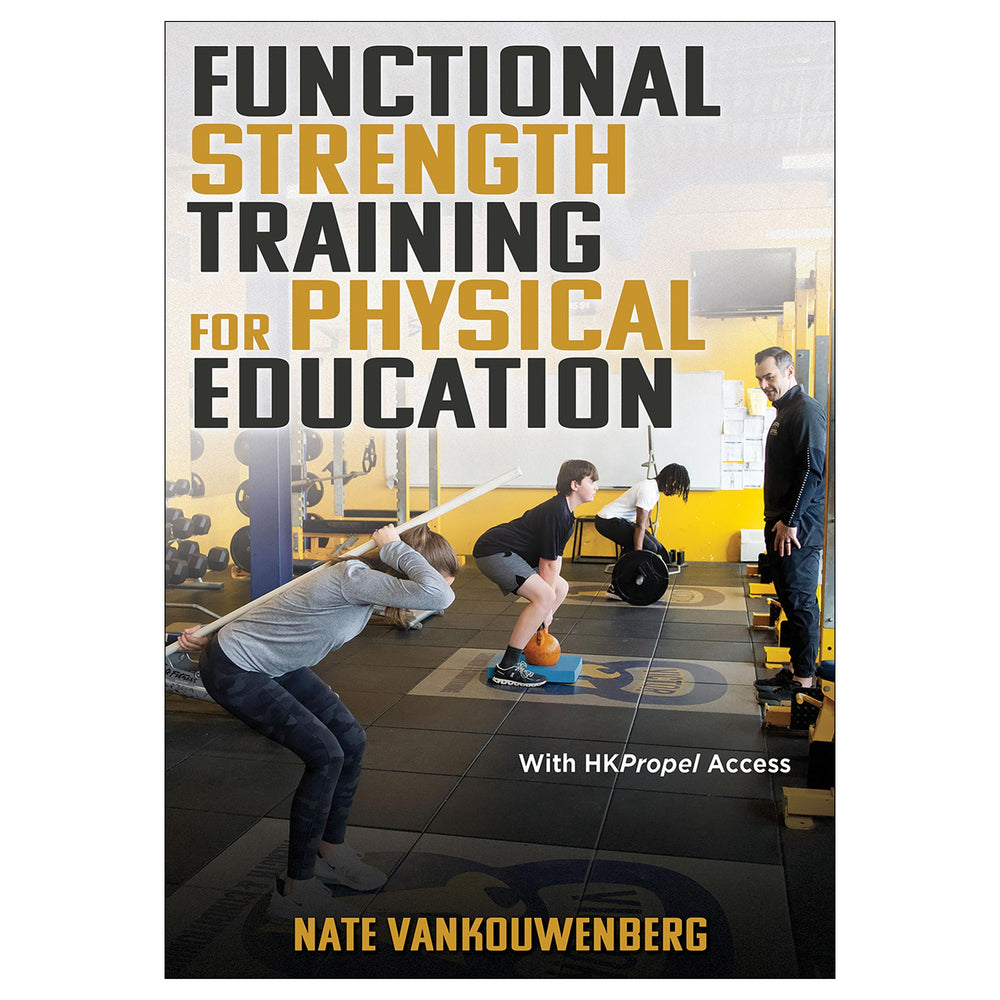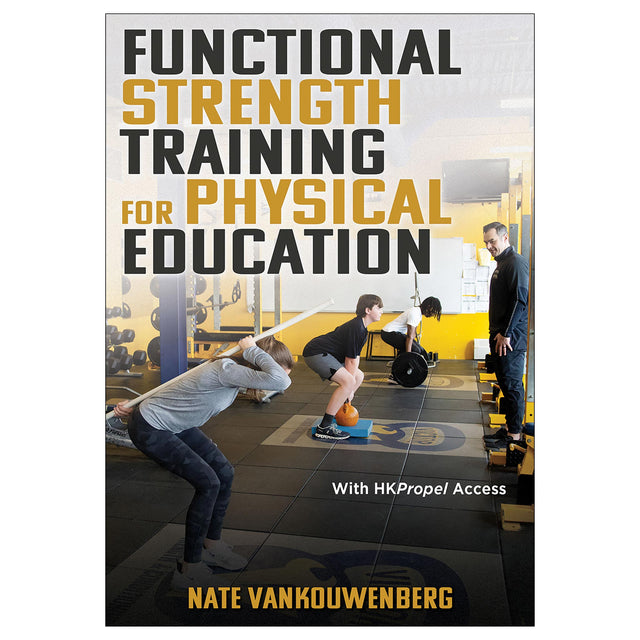Ebook With Online Resource
Functional Strength Training for Physical Education Ebook with HKPropel Access
Author: Nate VanKouwenberg
$37.00 USD
Unit price
/
Unavailable
Ebook With Online Resource
$37.00 USD
$37.00 USD

Ebook With Online Resource
Functional strength training is one of the most beneficial forms of fitness training, but it is often not included in a secondary physical education curriculum. Lack of equipment or weight rooms can be an issue, and uncertainty about how to teach students correct techniques can be intimidating. Plus, there may be misconceptions about strength training for secondary students, resulting in teachers excluding strength training or placing too much emphasis on machine-based isolation strength training.
Functional Strength Training for Physical Education offers an easy-to-implement approach for teachers of all experience levels. It provides secondary physical education teachers an understanding of functional strength training benefits and how to develop a program that will give all students skills for their lifetime, regardless of what activities and occupations they pursue. It also offers coaches and strength and conditioning professionals a wealth of information to develop student-athletes at the middle school and high school levels.
Functional Strength Training for Physical Education includes the following:
Author Nate VanKouwenberg, a physical education teacher and the owner of his own strength and conditioning business, provides guidance on how to perform functional skills with proper techniques and how to design quality workouts connected to students’ personal goals. His approach to functional strength training helps students enjoy the fitness methods and apply them to everyday activities outside of the classroom or training facility.
Functional Strength Training for Physical Education will help instructors provide secondary-level students the tools they need to build a strong foundation of fitness and wellness that will last for a lifetime.
Note: A code for accessing HKPropel is included with this ebook.
Functional Strength Training for Physical Education offers an easy-to-implement approach for teachers of all experience levels. It provides secondary physical education teachers an understanding of functional strength training benefits and how to develop a program that will give all students skills for their lifetime, regardless of what activities and occupations they pursue. It also offers coaches and strength and conditioning professionals a wealth of information to develop student-athletes at the middle school and high school levels.
Functional Strength Training for Physical Education includes the following:
- A comprehensive curriculum map to shape the program design, lesson planning, and assessments in the physical education setting
- Detailed lists of functional strength training skill progressions based on 11 different movement categories, including 83 exercise variations, to meet the needs of all students
- Step-by-step teaching methods and cues for all skill progressions to be used with or without equipment
- Facility design guidelines to maximize space and budget in the school or training facility setting
- Related online materials featuring 25 photo and video demonstrations with detailed exercise descriptions and external skill cues, as well as skill checklists, a sample curriculum map and design template, and templates for sport performance programs.
Author Nate VanKouwenberg, a physical education teacher and the owner of his own strength and conditioning business, provides guidance on how to perform functional skills with proper techniques and how to design quality workouts connected to students’ personal goals. His approach to functional strength training helps students enjoy the fitness methods and apply them to everyday activities outside of the classroom or training facility.
Functional Strength Training for Physical Education will help instructors provide secondary-level students the tools they need to build a strong foundation of fitness and wellness that will last for a lifetime.
Note: A code for accessing HKPropel is included with this ebook.
Audience
Secondary-level physical educators, middle and high school coaches, and strength and conditioning instructors who work with middle and high school athletes. Part I. Foundations of Functional Strength Training
Chapter 1. Strength Training for All
What Is Strength?
Strength Training Options
What’s Next
Chapter 2. Why Functional Strength Training?
Benefits of Functional Strength Training
What’s Next
Chapter 3. Functional Strength Training 101
Functional Joint-by-Joint Approach
Functional Movement Patterns Versus Muscle Groups
Planes of Motion
Unilateral Versus Bilateral Exercises
Debunking Common Strength Training Myths
What’s Next
Chapter 4. Functional Strength Training Progressions and Regressions
Implementing Skill Progressions and Regressions
Example Skill Variations
What’s Next
Part II. Functional Strength Training for Physical Education
Chapter 5. Why Functional Strength Training in Physical Education?
Benefits of Functional Strength Training in Physical Education
Challenges of Implementing Functional Strength Training in Physical Education
Tips for Implementing Functional Strength Training
What’s Next
Chapter 6. Curriculum Design
The Victor Way
Applying Skill Progressions to a Sequential K-12 Curriculum Map
Secondary PE Functional Strength Training Curriculum Outline
Using a Curriculum Map to Build a Unit Plan
FUNdamentals of Functional Strength Training in Elementary Physical Education
Connecting Functional Strength Training to National Standards
What’s Next
Chapter 7. Teaching Considerations
Class Management Strategies
Lesson Sequencing
Safety Considerations
Functional Strength Training and the Affective Domain
Modifications for Students With Disabilities
What’s Next
Chapter 8. Assessment
Why Assess?
Assessment Types
Cognitive Assessment
Using Assessments to Calculate Physical Education Grades
What’s Next
Part III. Functional Strength Training in Action
Chapter 9. Facility Design
Spatial Considerations
Equipment Considerations
Facility Flow
What’s Next
Chapter 10. Program Design
Exercise Selection
Volume
Intensity
Individualized Modifications Based on Personal Goals and Ability Level
What’s Next
Chapter 11. Connecting Functional Strength Training in Physical Education to Athletics
Goals of a Quality High School Strength and Conditioning Program
Extracurricular Sport Performance Program Design Guidelines
Strength and Conditioning Certification Recommendations
Closing Remarks
Appendix: Functional Strength Training for PE Resources
Chapter 1. Strength Training for All
What Is Strength?
Strength Training Options
What’s Next
Chapter 2. Why Functional Strength Training?
Benefits of Functional Strength Training
What’s Next
Chapter 3. Functional Strength Training 101
Functional Joint-by-Joint Approach
Functional Movement Patterns Versus Muscle Groups
Planes of Motion
Unilateral Versus Bilateral Exercises
Debunking Common Strength Training Myths
What’s Next
Chapter 4. Functional Strength Training Progressions and Regressions
Implementing Skill Progressions and Regressions
Example Skill Variations
What’s Next
Part II. Functional Strength Training for Physical Education
Chapter 5. Why Functional Strength Training in Physical Education?
Benefits of Functional Strength Training in Physical Education
Challenges of Implementing Functional Strength Training in Physical Education
Tips for Implementing Functional Strength Training
What’s Next
Chapter 6. Curriculum Design
The Victor Way
Applying Skill Progressions to a Sequential K-12 Curriculum Map
Secondary PE Functional Strength Training Curriculum Outline
Using a Curriculum Map to Build a Unit Plan
FUNdamentals of Functional Strength Training in Elementary Physical Education
Connecting Functional Strength Training to National Standards
What’s Next
Chapter 7. Teaching Considerations
Class Management Strategies
Lesson Sequencing
Safety Considerations
Functional Strength Training and the Affective Domain
Modifications for Students With Disabilities
What’s Next
Chapter 8. Assessment
Why Assess?
Assessment Types
Cognitive Assessment
Using Assessments to Calculate Physical Education Grades
What’s Next
Part III. Functional Strength Training in Action
Chapter 9. Facility Design
Spatial Considerations
Equipment Considerations
Facility Flow
What’s Next
Chapter 10. Program Design
Exercise Selection
Volume
Intensity
Individualized Modifications Based on Personal Goals and Ability Level
What’s Next
Chapter 11. Connecting Functional Strength Training in Physical Education to Athletics
Goals of a Quality High School Strength and Conditioning Program
Extracurricular Sport Performance Program Design Guidelines
Strength and Conditioning Certification Recommendations
Closing Remarks
Appendix: Functional Strength Training for PE Resources





